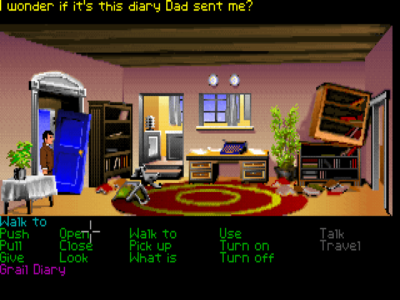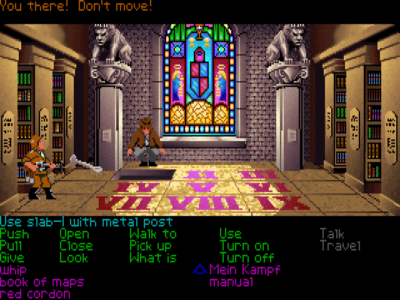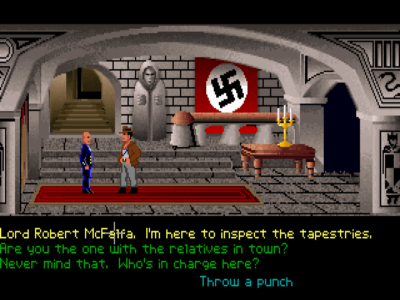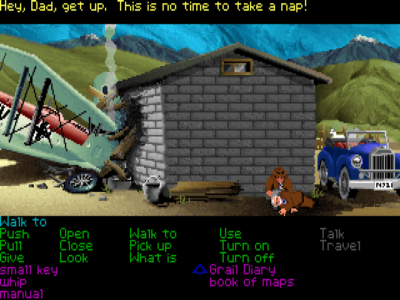
Indiana Jones and the Last Crusade
Written by: Rik
Date posted: September 2, 2007
- Genre: Adventure
- Developed by: LucasArts (LucasFilm Games)
- Published by: LucasArts (LucasFilm Games)
- Year released: 1989
- Our score: 5
I’m not normally one to make such sweeping statements, but pretty much everyone likes Indiana Jones. Okay, so there are obviously some people who prefer going to the theatre, but given the likely demographic for this site it’s unlikely they’re hunched over their keyboard reading this. Even those who don’t necessarily think that Star Wars is the best thing ever still seem to have a soft spot for Indy, and while there isn’t exactly mass hysteria surrounding the upcoming fourth film, there’s still a significant level of excitement, and above all (despite plenty of reasons to think otherwise) a genuine belief that it might actually be quite good.
We’ll find out about that soon enough, I suppose (and then I’ll probably have to come back and rewrite the start of this review, or at least insert some sarky comments in italics) but while there’s a decent chance of the LucasArts machine churning out a companion game to the upcoming film, it’s safe to say that it won’t be a 2D graphic adventure. The release of The Infernal Machine saw Indy go all 3D for the first time, placing the emphasis more on leaping across ravines and shooting Nazis (sorry, I mean Commies) than solving puzzles, which was all fair enough given that despite his academic credentials Dr. Jones is supposed to be an action hero. And, y’know, the whole thing about not making adventure games any more. Oh, and the fact the game was actually quite good.

Here’s a hint – pay a visit to your Dad’s house before you leave the US. And be prepared to do a bit of pixel-hunting.
Back in 1989, though, LucasArts were just starting to secure a reputation for half-decent adventure games, and quite reasonably they decided they could probably flog quite a few copies of one with Indiana Jones on the box. Sure enough, a tie-in with the third film was cooked up (in actual fact two games were released, the other being a (rightly) long-forgotten platformer) and this is the game we’re dealing with here. And so, following a short introduction sequence which combines young Indy’s sprint across the top of several train carriages (you know, from the start of the film) with a squeaky but recognisable attempt at John Williams’ score, you find yourself at Barnett College, NY, ready to embark on a series of adventures vaguely representative of those in the film.
When I say ‘vaguely representative’, I mean that while it obviously follows the plot of the film (if you haven’t seen it, shame on you, but look away now) in that Indy’s Dad goes missing and you travel to Venice and then Nazi Germany to rescue him before joining forces to go in search of the Holy Grail, you won’t be able to finish the game by virtue of having seen it a couple of times. Or a million times for that matter. While plenty of familiar scenes are re-enacted in chunky VGA, there’s a veritable shedload of puzzles which check your progress and generally make the game last longer than a couple of hours.
And last longer it will, because at times Indiana Jones and the Last Crusade can be ridiculously difficult. Even those with an appreciation that games were probably a lot tougher in the old days may still be slightly taken aback by a few of the conundrums you have to face here. Fans of later LucasArts adventures may be lulled into a false sense of security by the familiar SCUMM interface, but underneath it this game is quite a different beast. Whether this is a good or a bad thing depends on what you expect from your adventure game experience, but it certainly makes for a few head-scratching moments, as well as one or two ‘fist through the monitor’ ones.
The first thing to mention is that the game doesn’t protect you from yourself by ensuring you do everything you need to before allowing you to progress. In other words, you can end a section of the game without picking up a vital item that you are going to need later on. Unlike some adventures, you never get into a position where you’re totally screwed (ie in a totally impossible situation) as a result of missing something important, but you can make things very difficult for yourself. Most of the time you won’t even know you’ve missed something either – it’s not like a character will come up to you and say ‘give me this item or else it’s game over’ (what a game that would be, though), so if you’re operating on the understanding that this is, like most adventures, a totally linear experience, then things are going to seem ridiculously hard at times.
This isn’t a linear game though, and you can take one of a number of different(ish) paths through the game, making things easier or harder for yourself depending on what items you pick up, the dialogue choices you make, and generally how observant and conscientious you are when exploring the various locations on offer. Clearly, this sounds like quite a novel gameplay feature, and fans of the game could with some justification claim that this non-linearity is what makes Indy and the Last Crusade such a great adventure game. My own opinion is that while this certainly opens up some possibilities for replayability, the way it’s been implemented doesn’t necessarily make for a fun gaming experience.
Getting hold of useful items – ie things which you don’t necessarily need but would be extremely handy to have – is made pretty difficult, and even thorough gamers who try and look at everything in each location could easily still miss something important. Sometimes this is because what you’re after is extremely small, at other times you could be extremely close to something you need but, unlike in other adventures, your character gives you very few clues that it might be worth snooping around some more.
During the Venice section, for example, you can actually get hold of a couple of books from the library that’ll save you some trouble later on. With it being a library, there are loads and loads of books to look at, and whenever you do so, you get a fairly generic response from Indy, the type of which normally indicates that there’s nothing of interest here and that you’re wasting your time. Even if you persevere and manage to spot the (extremely) vague clues, you still have to indulge in a spot of pixel-hunting to secure the items in question. Clearly, the game intends to reward patient and careful gamers with bonus items in this way, but here it comes at the expense of making things more difficult for everyone else.
The punishment for missing certain items is usually pretty unpleasant. Sometimes you just have to play through a section that you’d otherwise be able to miss out, but most of the time it means having to endure additional arcade scenes. This comes mainly in the form of fist fighting with Nazis (and others), and in keeping with the rest of the game, it’s pretty damn tough. It’s no Street Fighter 2 either, and while it is apparently possible to develop a reasonable technique and strategy, my own attempts were swiftly abandoned in the heat of the battle in favour of a largely unscientific hammering of the keyboard. Frankly, it’s rubbish, and the game does its best to force you into fighting at every turn. Even if you have an item that’ll get you out of a fight, the game doesn’t signpost it for you, and though you can also talk your way out of trouble, too, finding the right response to do so is a bit of a minefield. Oh, and if you lose a fight, you die.
Eh? Yep, unlike in most LucasArts adventures, you can die. You’re also scored for your efforts throughout the game – if you pick up hard-to-find items and avoid punch-ups, you’ll get lots of points, if you don’t, then you, er, won’t (although you should receive some kind of prize for your total mastery of the fighting sections). These are the sorts of things you’d typically find in a Sierra adventure, and it’s worth bearing in mind that this game was released before LucasArts really secured their reputation within the genre. Another one of their hallmarks, namely decent dialogue, is also largely absent (see ‘We called the dog Indiana’) and as with many adventures of similar vintage, the focus is firmly on the puzzles.
Despite the almost overwhelmingly negative tone of this review, it’s worth pointing out that Indiana Jones and the Last Crusade isn’t rubbish or anything. Indeed, if you crave a tougher kind of adventure that offers you multiple paths through the game, it’s possible that you’ll really like it. Obviously, there’s also the fact that it’s Indiana Jones, too, and though it’s stretching it a bit to say that it’s just like playing through the movie, there’s plenty for fans of the films to enjoy. Ultimately, though, it can be quite a frustrating experience, and however much I wanted to really like it, the bouts of swearing and consultation of walkthroughs (sorry) indicate that at times it was a struggle. Worth a look then, but not one of LucasArts’ best.





 Posts
Posts